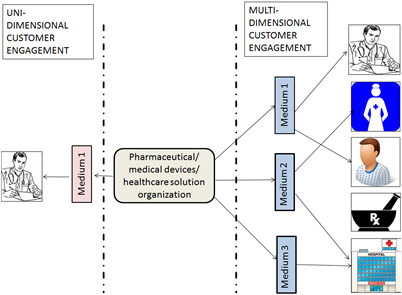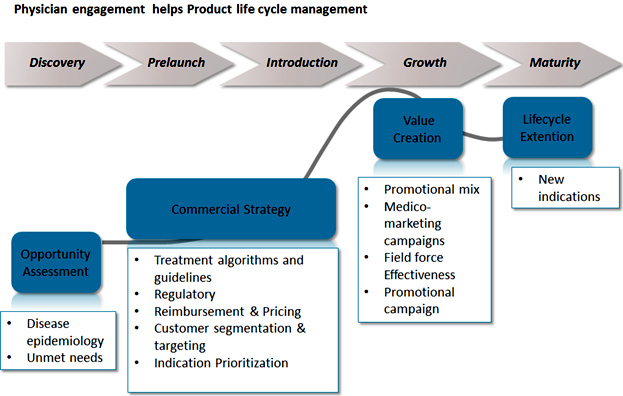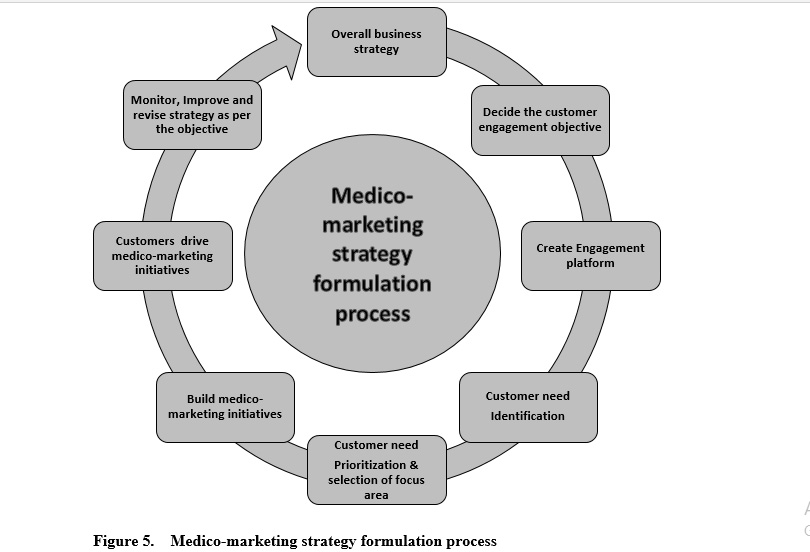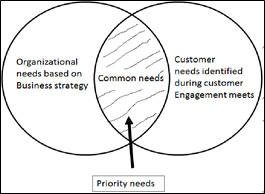Defending premium pricing is a challenge for pharmaceutical & medical device players globally. With the increasing tendency of governments worldwide intervening and attempting to make healthcare services more affordable and inclusive, this challenge continues to push companies to develop innovative strategies in marketing.
Stakeholder engagement through medical marketing strategies with appropriate planning and execution can lead to sustained value creation beyond product for which customers are more than willing to pay. This paper presents the planning and execution process of medico-marketing strategies for enhanced customer engagement and improved business outcomes.
Introduction
During the past decade, the pharmaceuticals and medical device business has undergone a paradigm shift from a collection of transactional events between the physician and a seller of product, to the continuum of care that includes a larger universe. In this continuum, medical product companies have been steadily expanding their role to have wider positive impact on their stakeholders. The pharmaceutical industry is no longer being rewarded for incremental innovation, me-too products and selling pills or devices. Companies need to demonstrate that their brand adds value to customers and they offer a value beyond product/service. A valued solution that a customer not only wants and needs but is willing to pay a premium for!.
With pressures of squeezing margins in mature markets, incremental growth in marketing expense is perceived as an additional burden on the bottom lines.
Figure1 illustrates that the pharmaceutical industry spends more than $27 billion on drug promotion, more than $24 billion on marketing to physicians and over $3 billion on advertising to consumers (mainly through television commercials). The numbers are increasing year on year. The total spending on prescription medicines has surged by 13.1% in 2014, to $373.9 billion.

Figure 1. Expenditure by type of pharmaceutical marketing
In emerging markets, like India, global pharmaceutical players have been quite successful in penetrating the market. The Indian drugs industry, which is valued at US$ 25.87 billion at present, according to Care Ratings, is also expected to grow in the local market with aggressive rural penetration by drug makers, increased government spending on health, and growing health awareness among people. Unlike pharmaceutical companies, global players in medical devices and Equipment industry have not found great success in penetrating the market given the same market situations and challenges. The Indian medical devices and Equipment industry valued at US$ 2.5 billion contributes only 6% of India�s US$ 40 billion healthcare sector. FICCI (Federation of Indian chambers of commerce and industries) in its report identified key challenges in the medical devices and equipment industry which are low penetration, low accessibility and low awareness. 2 In the same report FICCI�s recommendations to overcome these challenges were to increase the quality and enhance consistency of training received by medical and paramedical staff thereby providing creative resources for leading medical innovation efforts and to encourage greater collaboration between medical centers and technology universities. Such recommendations are important to keep in mind for planning of customer engagement strategies. In emerging markets, innovations in medico-marketing strategies have shown tremendous impact on the pharmaceutical business. Patient empowerment, wearable technologies, use of predictive biomarkers, virtual reality apps linked to healthcare, patient data security, privacy and accuracy etc. are few of the newer trends adopted by global pharmaceuticals to move from product-centric approach to a more patient-centric model. Customer centric strategies will help medical devices companies to increase penetration in emerging markets. Various strategies for customer engagement have been deployed by healthcare players. Physician and company representative engagement is the most obvious and still remains the core activity of pharmaceutical or medical devices companies. But different methods/channels of customer interactions may lead toy opportunities which converge into a multipronged engagement strategy. Let�s look at the two basic types of these engagement models.
Unidirectional engagement
This is a conventional engagement between a company representative and the physician which develops through the in-clinic interaction. Here, the company representative is a medium or channel. Very often this is a one sided communication about the disease, therapy and USP of the drug or device.
Majority of the Pharma marketing budgets are spent on this method which focusses on one customer which is the physician and one medium that is the sales representative. This engagement is typically transactional in nature.
Multidirectional engagement
Using this approach healthcare solution providers or product sellers can engage multiple customers through multiple mediums.
Different type of customers like physicians, paramedics, patients, pharmacists, healthcare institutes can be engaged by using various channels or mediums like digital or online, mobility, social media and print or web advertisements.
A well thought out Medico-marketing strategy helps companies leverage diverse mediums for multidirectional engagement.
Different Engagement models that are being leveraged by pharma marketers are depicted in figure 2 below.

Medium 1- in-person face to face meetings
Medium 2- Webinars
Medium 3- Social media
Figure 2. Basic types of Engagement model
Transactional engagement v/s partnership engagement
As mentioned above, conventional customer engagement is transactional in nature through which company representatives are perceived merely as product sellers by doctors. Globally, customer engagement and more specifically physician engagement has been under the scanner. In United States, under the Sunshine Act that is part of Patient Protection and Affordable Care Act, manufacturers have to report all payments for research, travel, honoraria and speaking fees, meals, educational items like textbooks and journal reprints.
Comparison of Spend on marketing strategies for customer engagement in transactional approach and partnership approach is depicted in figure 3
In a transactional engagement, initial returns are higher but diminish over period of time and are difficult to maintain longer
In a partnership approach, sellers transform themselves to take up a broader role so that doctors perceive them as partners in their clinical practice. In such an engagement, initial investments are higher but returns steadily increase and are better sustained as time progresses.

Figure 3. Engagement return on investment over a period of time
Customer engagement for sustained value creation around the core product
A healthcare marketer must influence multiple stakeholders to shape or expand the market. Physicians are the main decision makers in most of the situations, but inherent differences between devices and a pharmaceutical drug must be kept in mind. Efficacy of medical devices/technologies relies on the skills and experience of the physician, the quality of the hospital, and many other factors (which is not the case with pharmaceuticals due to their chemical nature - it either works completely or doesn't work completely).
Apart from physicians other customers are paramedical staff like nurses, physiotherapists, and respiratory therapists who are the end users for a product. Patients are most often the end beneficiaries of the product or service. For medical equipment business, engineers become important influencers from service & maintenance contract perspective.
Very often, with a strong focus on external customers, internal customers within an organization are ignored. But, for successful implementation of strategy and to have a positive impact on the business it is imperative that internal teams, especially the sales team owns the medico-marketing strategy and drives it in respective territories & customers.
An important prerequisite for building medico-marketing strategies is to identify and prioritize the type of customers with whom to engage. It is difficult to target all the customers with one strategy at any given time. Still, strategic initiatives can be designed to be more inclusive in terms of customer involvement. For example, training curriculum for nurses can be prepared by physicians and later executed in the form of series of workshops with the help of the sales team. Thus, with just one initiative three different sets of customers (Physicians, nurses and sales team) can be engaged.
Customer engagement is a long term process with tactical spur of activities based on the business plan or product life cycle stages. Figure 4 summarizes the different avenues of physician engagement throughout the product life cycle.

Figure 4. Physician engagement helps product life cycle management
Physician engagement that begins at the product discovery stage pays rich dividends. With proper customer engagement, pharmaceuticals can understand the geographic market real needs and these clinical insights from physicians can help them capture maximum of the market with better sales. Johnson and Johnson has developed a knee implant suitable for the Indian market as well as a reusable stapler for use in surgeries at price points, which are amenable to the Indian market. Roche Diagnostics has developed a screening device for cardio-vascular diseases, which is suitable for use in rural settings.
Philips Healthcare is using its recent acquisitions in India to develop and launch a low cost cardiac catheterization laboratory for the Indian market.
Similarly at every stage of the product, customers can be engaged through a blended strategic mix of medical and marketing strategy.
Medico-marketing strategy & customer engagement
While a well-designed medical marketing strategy can enhance customer engagement, it is also true that customer engagement can lead to robust medical marketing strategy formulation.
Process of building a medico-marketing strategy
An 8-step framework for building medico-marketing strategy is summarized in figure 5.

For a better understanding of the process, let us look at one type of customer - the Physician and build a process template that can then be applied to different customers as well. The process represents a true �democratic way of strategy formation� in which physician ideates, plans and partners to execute the strategy along with the healthcare product marketer leading to Medico-Marketing: Of the Physician, by the physician, for the physician.
The eight step process of medico-marketing strategy formulation is described below:
1. Overall business strategy
Medical marketing initiatives have their origins in the overall corporate business strategy. In fact, to ensure success they must be aligned with the overall business strategy
Case 1: Business objective of a medical device global leader was to increase market share by increasing the customer base and become a market leader in airway management products in India. The goal of medico-marketing strategy therefore, was to increase customer adoption of airway management products. To achieve this, end users i.e. paramedical staff were engaged in a yearlong training program on product usage which helped the company achieve market leadership.
2. Decide the customer engagement objective
One of the important outcomes of a medical marketing strategy is successful and sustained customer engagement. The organization and concerned internal stakeholders must identify the tangible objective behind such customer engagement.
Case 2: A MNC leader in prevention of migraine in India- The objective was identified so as to move away from being just a pill provider for the neurologists and become the therapy leader in migraine prophylaxis. Thus, an initiative called LEAD (Let Education and Awareness Defeat) migraine was launched. Under this medical marketing project, Key neurologists across the globe were engaged and education CME (Continuing Medical Education) seminars for doctors and patient education on migraine prevention was successfully carried out
3. Create engagement platform
The first step towards building a customer centric strategy is to bring key customers together on a single discussion platform
It is very important that the theme of the platform reflects the shared purpose and goal of the company and its customers
For example, themes like enhancing patient outcomes inspire both physicians as well as healthcare companies which have a patient centric vision
4. Customer need Identification
An unmet customer need provides not only a lead for product development but it is also an engagement opportunity. Brainstorming with customers is a good way to generate real time insights about customer needs. Figure 6 depicts few universal needs of any physician. Note that these are applicable to clinicians of all specialties across all geographies.

Figure 6. Few universal needs of a physician
5. Customer need Prioritization & selection of focus area
Focusing on multiple needs of Physicians can be a challenge for any organization. Identification of commonalities or similar purpose between needs of an organization and the needs of physicians is helpful in determining which needs to focus upon. Such common needs become priority needs (P-need) and this P- need becomes the origin of medico-marketing strategy. This concept is represented in the form of a simple Venn diagram in the figure 7 .

Figure 7. Identification of P- need
This is applicable at all levels: Organization or SBU or a brand. A P-need can be identified at a company level, corporate advisory board level or with key thought leaders at any specific brand level.
Case 3:
Organization need:
A Global leader in tracheostomy tubes wanted critical care specialists in their key geography to use their tubes which required a special technique.
Customer need:
Critical care specialists were keen to learn new techniques so as to enhance their clinical skills. Hence, this tracheostomy tube provider engaged a key opinion leader and tied up with a simulation training center which provided hands on training to critical care specialists on new techniques of tracheostomy. The strategy was beneficial for the company as well as for the clinicians.
6. Build medico-marketing initiatives
Projects/initiatives which originate from unmet needs of the physicians are more relevant and are realistic to their practice.
Case 4
A leader in airway medical devices in India partnered with top critical care specialists across India to develop an innovative educational initiative for paramedical staff to bridge the knowledge gap in Ventilator Associated Pneumonia (VAP) prevention practices.
Through this initiative a team of 500 nurse educators was formed and 4500 nurses were trained within a span of one year.
Case 5:
Listening to and responding to the �Voice of the Customer� (doctors) and the need of India�s patients � a MNC launched a patient assistance program called SPARSH (which means 'touch' in Hindi), which has touched 20000 patients over 110 towns in India. The program is offered to patients taking anti-diabetic medications upon recommendation from the prescribing physician. It offers comprehensive diabetes management including diet counseling, exercise counseling, education on diabetes and its complications all of which is delivered via a call center in Hyderabad, India.
Case 6
A MNC has launched Arogya Parivar (which means 'healthy family' in Hindi), to tap the bottom of pyramid population of India. It offers improved healthcare for 42 million people living in 33 000 villages, expanding their access to affordable products, improved health infrastructure and community education. It began returning profit within 30 months of its launch and since 2007, sales have increased 25-fold.
7. Customers drive medico-marketing initiatives
If physicians are involved in the planning of medico-marketing initiatives right from the beginning then their ownership and motivation levels are high. Clinicians themselves drive these initiatives in their respective hospitals using their sphere of influence.
Case 7:
A Medical Device Company needed to shape and prime the market for their innovative ambulatory pain management device which offered patient controlled analgesia and better patient satisfaction.
Anesthetists and Pain specialists in their KOL close group meeting with this Medical Device organization brainstormed about the current situation on pain management. They shared that in general, anesthetists and pain specialists felt the need of such innovative device but hospital management and surgeons were not in favor of this device due to fear of rise of the cost of surgery. During the same closed group meeting, anesthetists proposed that they needed to collaboratively prove to hospital management as well as operating surgeons about the deficiencies and low level of patient satisfaction with the current pain management practices. These group of anesthetists happily volunteered to play the role of investigators in a patient survey on pain satisfaction. This multi-country, multi-centric pain satisfaction survey with 1200 patients was first such attempt from Asian countries engaging 15 key institutes with great mix of academic institutes like AIIIMS (Delhi), PGI (Chandigarh), National hospital (Colombo) and private corporate hospitals like Apollo and Fortis. Through this initiative, along with top KOLs in the region, top hospitals were also engaged by medical device organization. KOLs from south Asia also authored an international publication which helped the organization to shape the market for their innovative pain management device.
8. Monitor, Improve and revise strategy as per the objective
Medico-marketing initiatives are most often long term projects and require project management skills to drive their timely completion and continuous feedback loops to plan for future initiatives.
Case 8:
Horlicks was the most trusted drinks brand of India in the year 2004. After nearly a decade GlaxoSmithKline decided to rework and make Horlicks �clinically proven brand�. They tied up with key pediatricians in India and conducted a clinical study in collaboration with national institute of nutrition, Hyderabad.
This study helped them to evaluate impact of Horlicks on growth and development in children. Five signs of growth like height, strength, healthy weight gain, blood health and concentration are now used by GSK in their claim of �Horlicks makes you stronger, sharper and smarter'.
What�s in store for customer engagement?
Life sciences companies are facing stricter compliances, increased competition and an urgent need to reduce �cost-to-serve.
The Healthcare market is transitioning to a more consumer-centric model. Driving this change are the informed and price conscious patients. Increasingly, patients are becoming key partners in the design and delivery of care. Pharmaceutical giants are engaging patients for development of crowd sourced drug discovery platforms. Technology enabled real-time interactions can empower patients to design, manage, and deliver the kind of care they need�the way they want it, at their desired place and time.
According to Peter Drucker the aim of marketing is to know and understand the customer so well that the product or service fits him and sells itself. As the maturity of relationship between patients and the healthcare ecosystem evolves, involvement of patients would become a standard norm